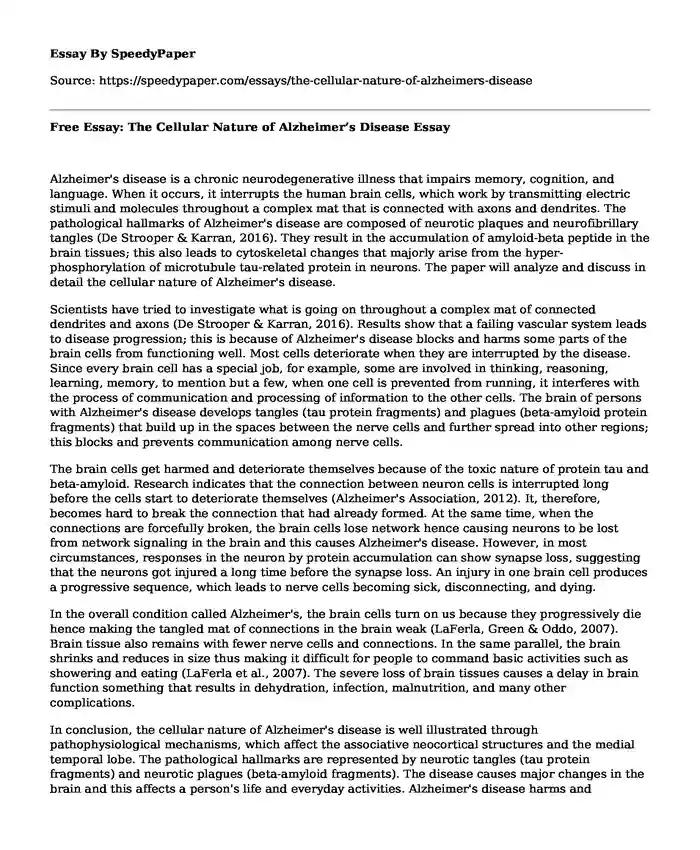
| Type of paper: | Essay |
| Categories: | Medicine Intelligence Dementia |
| Pages: | 3 |
| Wordcount: | 658 words |
Alzheimer's disease is a chronic neurodegenerative illness that impairs memory, cognition, and language. When it occurs, it interrupts the human brain cells, which work by transmitting electric stimuli and molecules throughout a complex mat that is connected with axons and dendrites. The pathological hallmarks of Alzheimer's disease are composed of neurotic plaques and neurofibrillary tangles (De Strooper & Karran, 2016). They result in the accumulation of amyloid-beta peptide in the brain tissues; this also leads to cytoskeletal changes that majorly arise from the hyper-phosphorylation of microtubule tau-related protein in neurons. The paper will analyze and discuss in detail the cellular nature of Alzheimer's disease.
Scientists have tried to investigate what is going on throughout a complex mat of connected dendrites and axons (De Strooper & Karran, 2016). Results show that a failing vascular system leads to disease progression; this is because of Alzheimer's disease blocks and harms some parts of the brain cells from functioning well. Most cells deteriorate when they are interrupted by the disease. Since every brain cell has a special job, for example, some are involved in thinking, reasoning, learning, memory, to mention but a few, when one cell is prevented from running, it interferes with the process of communication and processing of information to the other cells. The brain of persons with Alzheimer's disease develops tangles (tau protein fragments) and plagues (beta-amyloid protein fragments) that build up in the spaces between the nerve cells and further spread into other regions; this blocks and prevents communication among nerve cells.
The brain cells get harmed and deteriorate themselves because of the toxic nature of protein tau and beta-amyloid. Research indicates that the connection between neuron cells is interrupted long before the cells start to deteriorate themselves (Alzheimer's Association, 2012). It, therefore, becomes hard to break the connection that had already formed. At the same time, when the connections are forcefully broken, the brain cells lose network hence causing neurons to be lost from network signaling in the brain and this causes Alzheimer's disease. However, in most circumstances, responses in the neuron by protein accumulation can show synapse loss, suggesting that the neurons got injured a long time before the synapse loss. An injury in one brain cell produces a progressive sequence, which leads to nerve cells becoming sick, disconnecting, and dying.
In the overall condition called Alzheimer's, the brain cells turn on us because they progressively die hence making the tangled mat of connections in the brain weak (LaFerla, Green & Oddo, 2007). Brain tissue also remains with fewer nerve cells and connections. In the same parallel, the brain shrinks and reduces in size thus making it difficult for people to command basic activities such as showering and eating (LaFerla et al., 2007). The severe loss of brain tissues causes a delay in brain function something that results in dehydration, infection, malnutrition, and many other complications.
In conclusion, the cellular nature of Alzheimer's disease is well illustrated through pathophysiological mechanisms, which affect the associative neocortical structures and the medial temporal lobe. The pathological hallmarks are represented by neurotic tangles (tau protein fragments) and neurotic plagues (beta-amyloid fragments). The disease causes major changes in the brain and this affects a person's life and everyday activities. Alzheimer's disease harms and deteriorates brain cells. It, therefore, becomes difficult for a person to think, and reason because the brain cells cannot store and process information.
References
Alzheimer's Association. (2012). Basics of Alzheimer's Disease: What it is and what you can do. Alzheimer's Association. Retrieved from: https://www.alz.org/national/documents/brochure_basicsofalz_low.pdf
De Strooper, B., & Karran, E. (2016). The cellular phase of Alzheimer's disease. Cell, 164(4), 603-615. Retrieved from: https://www.sciencedirect.com/science/article/pii/S0092867415017201
LaFerla, F. M., Green, K. N., & Oddo, S. (2007). Intracellular amyloid-v in Alzheimer's disease. Nature Reviews Neuroscience, 8(7), 499-509. Retrieved from: https://www.researchgate.net/profile/Evgeny_Barykin2/post/How_do_peptides_and_proteins_escape_enodosomes_after_endocytosis/attachment/59d627a379197b8077985f0d/AS:326788287877120@1454923807625/download/LaFerla2007.pdf
Cite this page
Free Essay: The Cellular Nature of Alzheimer's Disease. (2023, Mar 28). Retrieved from https://speedypaper.com/essays/the-cellular-nature-of-alzheimers-disease
Request Removal
If you are the original author of this essay and no longer wish to have it published on the SpeedyPaper website, please click below to request its removal:
- Definition In Economics Essay Sample
- Essay Sample on Abusing Children Cases
- Student Leadership Essay Sample
- Free Essay: Analysis of Global Bank Strategies for Expansion
- Free Essay Sample on Macro Audit
- Free Essay on How It Is Possible to Change the World of Communication
- Free Essay Example on The Voting Rights Act
Popular categories




